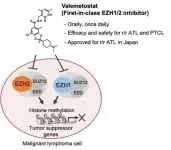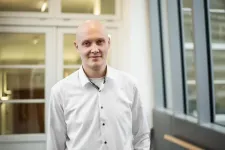(Press-News.org) Sometimes our bodies need a boost. Millions of Americans rely on pacemakers—small devices that regulate the electrical impulses of the heart in order to keep it beating smoothly. But to reduce complications, researchers would like to make these devices even smaller and less intrusive.
A team of researchers with the University of Chicago has developed a wireless device, powered by light, that can be implanted to regulate cardiovascular or neural activity in the body. The featherlight membranes, thinner than a human hair, can be inserted with minimally invasive surgery and contain no moving parts.
Published Feb. 21 in Nature, the results could help reduce complications in heart surgery and offer new horizons for future devices.
“The early experiments have been very successful, and we’re really hopeful about the future for this translational technology,” said Pengju Li, a graduate student at the University of Chicago and first author on the paper.
‘A new frontier’
The laboratory of Prof. Bozhi Tian has been developing devices for years that can use technology similar to solar cells to stimulate the body. Photovoltaics are attractive for this purpose because they do not have moving parts or wires that can break down or become intrusive—especially useful in delicate tissues like the heart. And instead of a battery, researchers simply implant a tiny optic fiber alongside to provide power.
But for the best results, the scientists had to tweak the system to work for biological purposes, rather than how solar cells are usually designed.
“In a solar cell, you want to collect as much sunlight as possible and move that energy along the cell no matter what part of the panel is struck,” explained Li. “But for this application, you want to be able to shine a light at a very localized area and activate only that one area.”
For example, a common heart therapy is known as cardiac resynchronization therapy, where different parts of the heart are brought back into sync with precisely timed charges. In current therapies, that’s achieved with wires, which can have their own complications.
Li and the team set out to create a photovoltaic material that would only activate exactly where the light struck.
The eventual design they settled on has two layers of a silicon material known as P-type, which respond to light by creating electrical charge. The top layer has many tiny holes—a condition known as nanoporosity—which boost the electrical performance and concentrate electricity without allowing it to spread.
The result is a miniscule, flexible membrane, which can be inserted into the body via a tiny tube along with an optic fiber—a minimally invasive surgery. The optic fiber lights up in a precise pattern, which the membrane picks up and turns into electrical impulses.
The membrane is just a single micrometer thin—about 100 times smaller than the finest human hair—and a few centimeters square. It weighs less than one fiftieth of a gram; significantly less than current state-of-the-art pacemakers, which weigh at least five grams. “The more lightweight a device is, the more comfortable it typically is for patients,” said Li.
This particular version of the device is meant for temporary use. Instead of another invasive surgery to remove the pacemaker, it simply dissolves over time into a nontoxic compound known as silicic acid. However, the researchers said that the devices could be engineered to last to different desired lifespans, depending on how long the heart stimulation is desired.
“This advancement is a game-changer in cardiac resynchronization therapy,” said Narutoshi Hibino, professor of surgery at the University of Chicago Medicine and co-corresponding author on the study. “We're at the cusp of a new frontier where bioelectronics can seamlessly integrate with the body's natural functions.”
Light use
Though the first trials were conducted with heart tissue, the team said the approach could be used for neuromodulation as well—stimulating nerves in movement disorders like Parkinson’s, for example, or to treat chronic pain or other disorders. Li coined the term ‘photoelectroceuticals’ for the field.
Tian said the day when they first tried the pacemaker in trials with pig hearts, which are very similar to those of humans, remains vivid in his memory. “I remember that day because it worked in the very first trial,” he said. “It's both a miraculous achievement and a reward for our extensive efforts.”
A screening method developed by Li to map the photoelectrochemical output of various silicon-based materials could also have uses elsewhere, Tian pointed out, such as in fields like new battery technologies, catalysts, or photovoltaic cells.
END
UChicago scientists invent ultra-thin, minimally-invasive pacemaker controlled by light
Ultralight membrane can regulate heartbeats with the aid of an optic fiber
2024-02-21
ELSE PRESS RELEASES FROM THIS DATE:
Accelerometer-measured physical activity, sedentary time, and heart failure risk in older women
2024-02-21
About The Study: The results of this study of 5,951 women ages 63 to 99 suggest that promoting regular physical activity and minimal sedentary time may be prudent for primary prevention of heart failure and its subtype with preserved ejection fraction for which treatment is limited.
Authors: Michael J. LaMonte, Ph.D., M.P.H., of the University at Buffalo—SUNY, is the corresponding author.
To access the embargoed study: Visit our For The Media website at this link https://media.jamanetwork.com/
(doi:10.1001/jamacardio.2023.5692)
Editor’s Note: Please see the article for additional information, including other ...
Lifetime suicide attempts in otherwise psychiatrically healthy individuals
2024-02-21
About The Study: In this study using data from 1,948 U.S. adults with lifetime suicide attempts from a nationally representative population-based survey, an estimated 19.6% reported not having met criteria for any psychiatric disorders prior to their first attempt. This finding challenges clinical notions of who is at risk for suicidal behavior and raises questions about the safety of limiting suicide risk screening to psychiatric populations.
Authors: Maria A. Oquendo, M.D., Ph.D., of the University of Pennsylvania in Philadelphia, is the corresponding author.
To access the embargoed study: Visit our For The Media ...
Acupuncture for combat-related posttraumatic stress disorder
2024-02-21
About The Study: The acupuncture intervention used in this randomized clinical trial including 93 participants was clinically efficacious and favorably affected the psychobiology of posttraumatic stress disorder (PTSD) in combat veterans. These data build on extant literature and suggest that clinical implementation of acupuncture for PTSD, along with further research about comparative efficacy, durability, and mechanisms of effects, is warranted.
Authors: Michael Hollifield, M.D., of the Tibor Rubin VA Medical Center in Long Beach, California, is the corresponding author.
To access the embargoed study: Visit our For The Media website at this link https://media.jamanetwork.com/
(10.1001/jamapsychiatry.2023.5651)
Editor’s ...
Study finds high number of persistent COVID-19 infections in the general population
2024-02-21
New study finds that persistent COVID-19 infections are surprisingly common, with around one to three in every 100 infections lasting a month or longer.
Some persistent infections had a high number of mutations, suggesting they could act as reservoirs to seed new variants of concern.
People with persistent infections lasting for 30 days or longer were 55% more likely to report having Long Covid than people with more typical infections.
Reinfections with the same variant were rare.
A new study led by the University of Oxford has ...
Researchers reveal mechanism of drug reactivating tumor suppressors
2024-02-21
Researchers have revealed the mechanism of a drug shown to be effective in treating certain types of cancer, which targets a protein modification silencing the expression of multiple tumor suppressor genes. They also demonstrated in clinical trials the efficacy of the drug in reducing tumor growth in blood cancer. The findings could lead to longer-term treatments for the disease and therapies for other types of cancer with similar underlying causes.
A team of researchers from the University of Tokyo and their collaborators focused on therapies targeting H3K27me3, a modification on a DNA-packaging histone protein, which plays a large role in regulating ...
UNC Lineberger named as a national research hub for NIH cancer screening study
2024-02-21
CHAPEL HILL, NC – UNC Lineberger Comprehensive Cancer Center has been selected as one of nine national research sites for the National Cancer Institute’s (NCI), part of the National Institutes of Health, newly launched Cancer Screening Research Network (CSRN), which will evaluate promising and emerging cancer screening technologies.
Supporting the Biden-Harris Administration’s Cancer Moonshot initiative, the CSRN will conduct large, multi-center cancer screening studies with diverse populations in a variety of healthcare settings. The studies are designed to identify ...
New study suggests target steps per day for reduced risk of heart failure
2024-02-21
BUFFALO, N.Y. – The science is clear that movement is good for our bodies as we age. But just how much physical activity is beneficial for people over 60? A new study from the University at Buffalo provides an answer, and it’s not 10,000 steps per day.
In fact, the study — published Feb. 21 in JAMA Cardiology — of nearly 6,000 U.S. women aged 63-99 reports that, on average, 3,600 steps per day at a normal pace was associated with a 26% lower risk of developing heart failure.
The observational study from the Women’s Health Initiative ...
NIH launches research network to evaluate emerging cancer screening technologies
2024-02-21
The National Institutes of Health (NIH) has launched a clinical trials network to evaluate emerging technologies for cancer screening. The Cancer Screening Research Network (CSRN) will support the Biden-Harris administration’s Cancer Moonshot℠ by investigating how to identify cancers earlier, when they may be easier to treat. Eight groups have received funding from the National Cancer Institute (NCI), part of NIH, to carry out the initial activities of the network.
“There are many cancers we still cannot reliably ...
Evidence review: Maternal mental conditions drive climbing death rate in U.S.
2024-02-21
WASHINGTON (Feb. 21, 2024) – Painting a sobering picture, a research team led by Children’s National Hospital culled years of data demonstrating that maternal mental illness is an under-recognized contributor to the death of new mothers. They are calling for urgent action to address this public health crisis in the latest edition of JAMA Psychiatry.
Backed by dozens of peer-reviewed studies and health policy sources, the journal’s special communication comes as maternal mortality soars ...
Scientists from IOCB Prague have improved materials for reconstructive and plastic surgery
2024-02-21
Researchers from IOCB Prague and Ghent University have been working on improving the properties of gelatin-based materials, thereby expanding the possibilities of their use mainly in medicine. In a paper published in ACS Applied Engineering Materials, they have presented 3D-printable materials that can be easily monitored using an X-ray machine or through computed tomography (CT).
Gelatin-based materials have been a hot topic of research in the last ten years because they are straightforward to produce, non-toxic, inexpensive, ...
LAST 30 PRESS RELEASES:
Bis-pseudoindoxyls: a new class of single benzene-based fluorophores for bioimaging applications
Blocking a cancer-related pathway helps reduce spine deformities due to genetic disorder, finds new study
New study explores therapeutic potential of CRISPRCas3 genome-editing system
Korea University researchers revive an abandoned depression drug target using structurally novel NK1 receptor inhibitors
Jeonbuk National University researchers highlight advancements in chemical looping fluidized bed reactors
Tyrannosaurus rex grew up slowly: New study reveals the “king of dinosaurs” kept growing until age 40
Commercial water dispenser machines may contain more contamination than tap water
Death and doctors: New WSU study looks at medical student education on end-of-life care
The best hydrogen for heavy-duty transport is locally produced and green
Pregnancy-related high blood pressure varied among Asian, Pacific Islander subgroups
Measuring movement creates new way to map indoor air pollution
Europe’s crop droughts to get worse even as rain increases
New study identifies signature in blood to better predict type 2 diabetes risk
Research spotlight: developing “smart” nanoparticles to deliver targeted gene therapy in osteoarthritis
A CRISPR fingerprint of pathogenic C. auris fungi
Time warp: How marketers express time can affect what consumers buy
CBD treatment reverses key effects of fetal alcohol spectrum disorder in a mouse model
Blood sugar spikes linked to higher risk of Alzheimer's disease
Staying single for longer affects young people’s well-being
New method allows scientists to 3D-print structures within cells
Screening tool helps identify brain-related comorbidities in individuals with Duchenne muscular dystrophy
How do the active ingredients of monkfruit affect health?
News language and social networks: how do they affect the spread of immigration attitudes?
Researchers discover trigger of tendon disease
Your pet's flea treatment could be destroying the planet
Diabetes risk not associated with timing or type of menopause
Bulk inorganic crystals grown from water emit “handed” light
A new AI-based attack framework advances multi-agent reinforcement learning by amplifying vulnerability and bypassing defenses
While exploring the cosmos, astronauts also fuel explorations of the biology of aging and cellular resilience
Design and synthesis of Zr-IR825 nanoparticles for photothermal therapy of tumor cells
[Press-News.org] UChicago scientists invent ultra-thin, minimally-invasive pacemaker controlled by lightUltralight membrane can regulate heartbeats with the aid of an optic fiber


